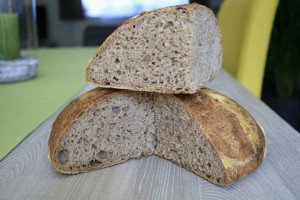This must be my most successful miche to date. There are so many recipes inspired by a pain poilâne it’s hard to keep track of. Jeffrey Hamelman has one in his book BREAD, Peter Reinhart has one in his book Bread Baker’s Apprentice and in my most recent book I’ve seen a version from Daniel Leader in “local breads“. I wasn’t really looking for another miche style French levain bread but wanted to try out different techniques I’ve found at The Fresh Loaf on how to get moure sour out of your sourdough.

So while I was at it, why not try something new? This is an adapted version from Leader’s pain au levain complet. I noticed I still had a bag of spelt flour unopened I wanted to try. (épautre is French for spelt).
**I’ve learned the following things **on how to “improve” the sourness level of your sourdough bread:
- Use a stiff levain – it builds up slower and develops more acids that way.
- Ferment longer – quite obvious, right? I never fermented longer than 2 hours (bulk), so this was relatively new for me
- Use a levain with wholegrain – it has a higher ash content and will act as a buffer for the lactic acids before they break down the yeast or gluten.
- Retard your dough in the fridge for 12 to up to 24 hours.
The Recipe
Preferment
- 50gr starter, I used my “loose” rye starter (60-70% hydration, not sure but does not matter)
- 50gr stone-ground organic wholewheat flour
- 50gr spelt flour (this is not wholegrain)
- 75gr water
- 400gr organic stone-ground wholewheat flour
- 100gr spelt flour
- your starter (125gr total, I think)
- 375gr water
Time table:
- autolyse 30 minutes
- kneading using the french fold technique for about 15 minutes (a little longer than usual! This makes sure we get evenly distributed holes)
- Bulk fermenting for 4 hours with 3 stretch & folds, more could be needed for your flour, that’s OK. It was at room temp, at that time 23°C.
- Retard for 12 hours in the fridge at 5°C.
I baked it straight from the fridge, called a “cold bake”, with some steam injected into the oven. It is actually not really needed to slash this boule, as wholewheat does not get a huge oven spring anyway and you might want to decorate your loaf with some flour.

<p>
<span style="font-style: normal;">A closer look at the interior, look how dark and holey it is!</span>The flour is locally milled and simply <strong>amazing</strong> – you can stretch it a lot without tearing (see the pictures!), it’s very very finely ground, it’s local and it’s cheap (and of course stone-ground, meaning no single bran left out and I did not sift anything). I did not want to use another “T85” kind of flour (85% extraction, meaning 15% bran sifted out). I simply love it this way.
</p>
- It’s healthy: wholegrains > white bread!
- It’s extremely tasty, with just the right amount of sourness. It may be a bit too much for some, but I like it that way. As you may now, I’ve been searching on how to get more sour for my daily recipe – I might have found an improved version!
- The “holes” in the bread are more dense but that’s exactly what we want here, no jam falling out!
I’ve learned a lot baking this bread and it’s simply delicious. I’m baking this thing again, that’s for sure!
